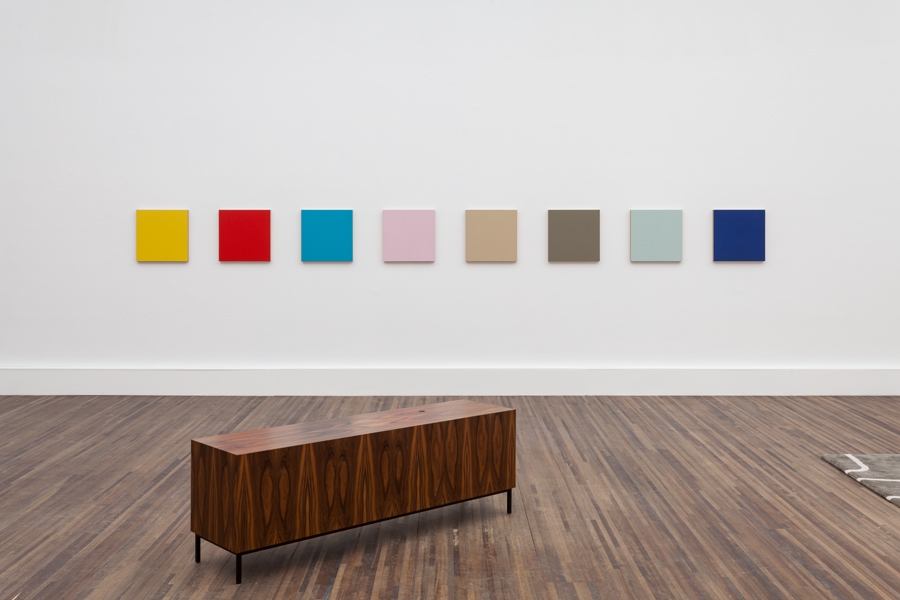A coalescence of two mischievous minds, Persiana combines work from the decade-long partnership of Carla Arocha and Stéphane Schraenen into an elegant meditation on the alchemy and treachery of perception. The shapeshifting Mechelen Marauder (2014), a spectacular cylinder hanging in the circular entryway, augurs what is to come: fragmenting its surroundings in innumerable mirrored pieces joined by S-shaped hooks, it alternately shimmers or fades from sight. Around the corner is a succinct expression of the exhibition’s central notion: opaque white rectangles linked together in a grid and suspended off the wall, Persiana I (2007) reflects its title as a moniker for Venetian blinds and, highlighting the dubious duality of inside versus outside, leaves the obscured view to the imagination.
There is no inside to Credenza, Cabinet and Bedside Table (all 2013), whose shapes signal the functional furniture for which they were named. Made of the darkly grained wood used for modernist design classics by Charles and Ray Eames, and matching the gallery floor, they are all surface. Inset peepholes inviting visitors to peer at their contents merely look through to the other side. You are left to your own devices: each mute piece carries myriad associations depending on the state of the mind regarding it. In the centre of the space, Carpet (2014) appears to be a commonplace accessory of the type found at Ikea or another chic furnishing store. Adorned with sinuous white lines on a grey background, it is actually a copy of a depiction of a carpet photographed from a distorted angle, mimicking the mechanics of memory and further warped by a viewer’s perspective. The overall effect is both uncanny and strangely familiar; together with the furniture, it evokes a dreamlike amalgam of all the homes you’ve lived in.
The pristine exhibition conveys a sense of balance and proportion, yet nothing is exactly what it seems. Colour is a particularly evocative medium for perceptual relativity, as its insubstantial properties are dependent entirely upon contextual conditions. Frieze II (2014) demonstrates the evanescent nature of hue: the uppermost surface of a white ledge painted with fluorescent orange casts a glow that mutates in form and intensity, like a sunset, in tandem with the daylight entering through the glass roof. Opposite is Breath (2013), where eight monochrome squares arranged in a series along the wall are perceived as paintings due to their presentation; the surfaces are actually textured leather skins whose tactile nature contradicts the fugitive ephemerality of colour.
Naturally there are many versions of windows. Curtain (2008), a photograph of heavy formal drapes behind glass, might recall a prim maternal skirt, concealing dangerous secrets that you both do and don’t want to know. Chris Box (2008) resembles a psychedelic mashrabiya screen, its open cross forms multiplying infinitely through reflective layers. The view within In Paradise Series: Window (2008), a photo printed on glass and placed over a mirror to three-dimensional effect, is fogged by what appears to be rain droplets on its surface. The austere and ominous Three Lies, a trio of crystal spheres resembling alien eyes on pedestals, reflects whirling concentric versions of the room and its inhabitants. Arrayed on the floor, Rooms II (2010) comprises formations in marble, architectural layouts that invoke remains of an ancient civilisation, whose irregular shapes counter the symmetrical squares of the modernist building’s ceiling panes.
Dazzling reflections of spinning disco balls in a dark room, Twins (2007–14) – multicoloured shapes emitting from one and black-and-white from the other – stir, as strongly as a scent, the vague recollection of a night long forgotten. Sealed in a vitrine as befits a precious jewel or a deadly device, the two-finger ring C.T. Knuckle Duster (2014) is a talisman whose multifaceted crystals, peered into, explode the room in a zillion refractions. Here the sculptures appear innocent; we are the perpetrators, our minds both lethal weapons and magic wands, transforming inner visions into physical entities. The show itself, in this regard, suggests an immersive prism reflecting various layers of reality and the gaps in between: the deceptiveness of perpetually pulsating physical space.
This article was first published in the March 2014 issue.
